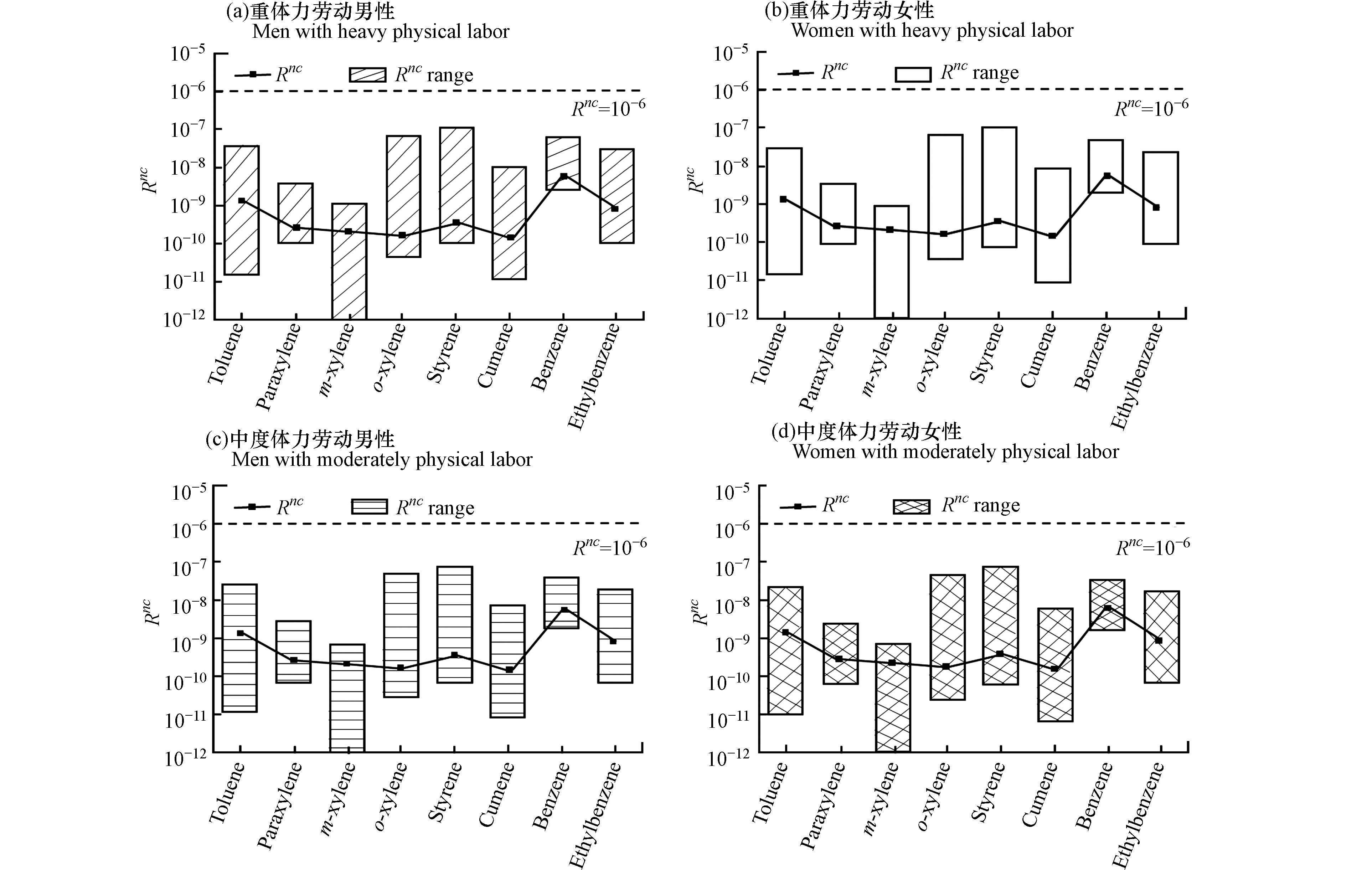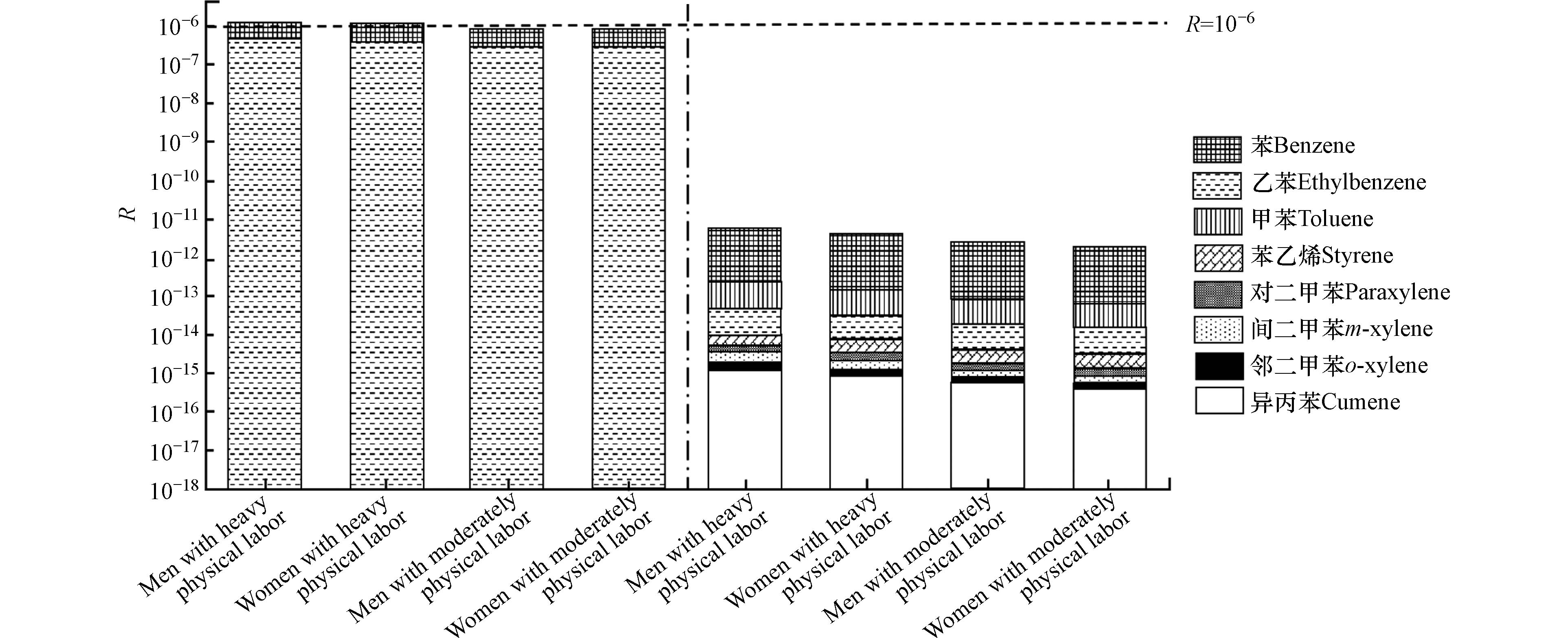-
造成环境空气污染的主要挥发性有机化合物中,以苯、甲苯、乙苯、二甲苯等为首的苯系物因其熔沸点较低,极易挥发,且具有对人体健康的致癌和非致癌危害而备受关注[1]. 环境空气苯系物主要源于工业生产、装修材料、燃料排放、垃圾和废弃物等[2-4],在人体内累积易导致呼吸系统、血液系统、生殖系统和神经系统疾病,长期接触致癌物苯、乙苯甚至会导致严重疾病,如淋巴瘤、白血病等[5-6]. 再生塑料颗粒以废弃的塑料制品为原料加工而成,因其在经济、技术和环境友好性上的可替代性[7-8],使人们逐步将再生塑料颗粒作为主要的加工原料. 其生产过程中的苯系物污染,主要源于各类增塑剂、阻燃剂等有机溶剂[9-11]. 针对苯系物对人体的危害,已有学者评估了高剂量的苯系物在室内环境、家具制造、大气污染、职业暴露等方面的健康风险[12-15],对塑料制品中添加剂对人体的健康影响也有一定研究[16-18]. 低剂量的苯系物在非职业暴露下可能存在健康风险[19,20],因而低剂量苯系物对作业人员的健康风险逐渐成为关注热点[21-23]. 有学者针对消费品和工业产品进行了基于暴露场景假设的特定暴露源苯系物健康风险评估研究[24-26],由于生产需求,从事再生塑料颗粒加工的作业人员对塑料颗粒这一特定暴露源的直接接触不可避免,并且是一个长期、稳定,并伴随作业人员整个职业周期的过程,因此,需要关注从再生塑料颗粒中挥发的苯系物对作业人员的健康风险.
本文采集市面上25种以聚丙烯 (polypropylene, PP)、高密度聚乙烯 (high density polyethylene, HDPE)、丙烯腈-丁二烯-苯乙烯共聚物 (acrylonitrile butadiene styrene, ABS)、高抗冲击聚苯乙烯(high impact polystyrene, HIPS)、聚酰胺 (polyamide, PA)为主要成分的再生塑料颗粒,检测并分析8种苯系物(苯、甲苯、乙苯、对二甲苯、间二甲苯、邻二甲苯、苯乙烯、异丙苯)的挥发浓度. 根据美国环境保护署 (United States Environmental Protection Agency, USEPA)推荐的暴露模型,构建“两步法”风险评估模型:暴露量计算模型和风险表征模型,并基于暴露场景假设法构建了再生塑料颗粒加工车间暴露环境,评估可挥发性苯系物对作业人员的健康影响风险水平.
-
针对PP、HDPE、ABS、HIPS、PA等5种常见再生塑料颗粒,采集25种不同用途的再生塑料颗粒用于检测苯系物挥发浓度,其基本属性如表1所示. 本文所研究的再生塑料颗粒样品均为加工成品塑料颗粒,每包重量为25 kg,再生塑料颗粒单个样品的尺寸均小于1 cm×1 cm×1 cm.
-
称取苯、甲苯、乙苯、对二甲苯、间二甲苯、邻二甲苯、苯乙烯、异丙苯标准样品(纯度≥99%,国家标准物质信息网)各0.2000 g加入到有少量丙酮溶液(纯度≥99 %,国药集团化学试剂有限公司)的100 mL容量瓶中,摇匀混合后加入丙酮溶液定容,得到浓度为2 g·L−1的标准贮备液. 再用丙酮溶液稀释成0.1、0.05、0.02、0.01 g·L−1的系列标准使用液,放入冰箱中保存备用. 实验中设置空白基质,除不加样品外还采用与样品检测相同的程序,并且要求其检测结果小于定量限. 由于再生塑料颗粒样品的尺寸均小于1 cm×1 cm×1 cm,因此不用预处理,直接将样品低温冷冻后迅速放入研磨机中,研磨后备用.
对苯系物等挥发性组分进行分析,采用顶空进样法对组分进行气相色谱-质谱(Gas Chromatography-Mass Spectrometry, GC-MS)分析时的效果良好[27]. 电子天平称量待测样品0.1000 g置于20 mL顶空瓶内,放入顶空自动进样装置. 顶空进样器条件:加热箱140 ℃,定量环150 ℃,传输线160 ℃,GC循环时间60 min,样品瓶平衡时间45 min. 色谱质谱条件见表2. 在设定条件下,分别向5个含有0.1000 g空白基质的顶空瓶内加入含0.1、0.2 、0.5、1.0、2.0 μg的混合标准溶液,进行检测分析并绘制标准曲线. 取待测样品0.1000 g置于顶空瓶内,迅速盖上瓶盖,放入顶空自动进样装置,在140℃ 平衡温度下平衡45 min,然后注入GC-MS(Agilent 7697A,20 mL 顶空进样瓶,安捷伦公司,美国)对可挥发性苯系物含量进行检测分析.
所有实验数据均基于以上设计过程,重复 3 次,实验中按照标准溶液建立的苯系物工作曲线其相 关性 r 2 为 0.992—0.995.
-
根据USEPA的暴露评估公式[28-30],构建“两步法”健康风险评估模型:第一步为暴露量计算模型,在工业生产中,吸入是接触可挥发性苯系物的主要暴露途径[31]. 因此,第一步用于计算在再生塑料颗粒加工过程中,可挥发性苯系物对作业人员的呼吸暴露量;第二步是风险表征模型,用于评估苯系物对作业人员经呼吸暴露的健康风险水平.
-
根据再生塑料颗粒加工过程苯系物对不同暴露群体的影响不同,参考一般工业厂房设计规范,设计再生塑料颗粒加工暴露场景为:单层厂房面积为500 m2,高度为6 m,厂区内通风状态一般,作业人员实行三班倒制,每天工作8 h. 并根据劳动强度,将作业人员划分为中度体力劳动男性(女性)和重度体力劳动男性(女性)共四类.
暴露量计算分为作业人员呼吸所接触到的可挥发性苯系物浓度Cinh (mg·m−3)、吸入量Iinh (mg)及经呼吸暴露量Exinh [mg·kg−1·d−1]三部分,其计算公式参照(1)、(2)、(3). 模型中各参数设定见表3,当参数无具体参考时,从暴露评估最严苛角度,选取导致最危险状态的参数取值.
-
评估作业人员健康风险时,可挥发性苯系物按照其可能导致的不同健康危害效应分为致癌和非致癌风险两类[35],从而将风险表征模型分为非致癌风险表征模型和致癌风险表征模型. 式(4)为非致癌风险Rnc计算公式,式(5)为致癌风险Rc计算公式,综合风险R采用累加的方式,见式(6),其中i指第i种物质,j指第j种暴露途径. 此外,致癌污染物的斜率因子SF和非致癌物的参考剂量RfD均采用USEPA综合风险信息系统[36]提供的资料,见表4. 式中
$ {\text{1}} \times {\text{1}}{{\text{0}}^{ - 6}} $ 是健康风险评估的可忽略风险水平,被用作人体终生癌症风险的可接受临界阈值[37]. -
将再生塑料颗粒中8种可挥发性有机苯系物的检测数据作简单统计,见表5. 可挥发性苯系物在25种再生塑料颗粒样本中均有检出,甲苯和异丙苯的检出率最高(92%). 可挥发性苯系物的总体检测浓度范围在9.26×10−8 —8.68×10−1 mg·kg−1,总体挥发浓度较低. 其中,苯乙烯的挥发量最多,平均浓度达到0.198 mg·kg−1,间二甲苯次之,苯的挥发量最小.
进一步结合四分位稳健法 (inter quartile range, IQR) 分析检测数据,除间二甲苯外,其余7种苯系物检测数据标准差远大于标准稳健度,说明IQR在异常值检出的灵敏度上明显高于传统分析方法[38],间二甲苯由于检出率低,采用传统分析方法效果更好. 因此,间二甲苯选用样本平均值作为再生塑料中可挥发性苯系物的检测浓度关键值,检测浓度范围作为作业人员可能接触的可挥发性苯系物浓度范围. 对其余7种苯系物,取P50作为检测浓度关键值,P2.5—P97.5作为浓度范围.
结合式(1)计算厂房内可挥发性苯系物浓度Cinh,见表6. 在设定的暴露场景下,厂房内8种苯系物浓度水平排序为:甲苯>乙苯>苯乙烯>对二甲苯>间二甲苯>邻二甲苯>苯>异丙苯,浓度均值为2.71×10−4 mg·m−3,虽然各苯系物浓度水平结果同El-Hashemy等[39]监测印刷厂、Singh等[40]监测购物中心内苯系物浓度水平结果略有差异,但一致得到了甲苯浓度是苯系物中浓度最高的这一结论,说明构建的暴露场景具有适用性,从而保证了后续评价结果的可靠性. 将厂房内苯系物浓度水平同《工作场所有害因素职业接触限值》标准进行比对,结果表明8种苯系物浓度范围上限平均低于标准限值4—5个数量级,属于低污染水平.
-
再生塑料颗粒中具有非致癌影响的苯系物包括甲苯、对二甲苯、间二甲苯、邻二甲苯、苯乙烯、异丙苯,具有致癌影响的物质包括苯、乙苯. 由于致癌物质危险性较高,其非致癌影响也应当考虑. 综上,结合式(1)—(3)计算可挥发性苯系物对四类暴露群体的暴露量,结果见表7所示.
8种可挥发性苯系物的非致癌暴露影响排序为:甲苯>乙苯>苯乙烯>对二甲苯>间二甲苯>邻二甲苯>苯>异丙苯,其中甲苯的暴露量最高,Exinh(重度体力劳动男性)=1.9328×10−4 mg·kg−1·d−1,占非致癌影响总暴露量的39.78 %,乙苯次之,占25.96 %. 2种具有致癌影响的物质中乙苯的暴露量高于苯,占致癌影响总暴露量的74.16 %.
综合分析发现,在从事重体力活动时,男性作业人员呼吸速率要远远大于女性,因而暴露量排序为Exinh(重体力劳动男性)>Exinh(重体力劳动女性)>Exinh(中度体力劳动男性)>Exinh(中度体力劳动女性). 此外,由于8种苯系物均具有非致癌暴露影响,因此可挥发性苯系物对不同群体暴露量的主要来源是非致癌影响暴露量.
-
苯及乙苯对四类暴露群体的致癌风险水平排序为:Rc(重度体力劳动男性)>Rc(重度体力劳动女性)>Rc(中度体力劳动男性)>Rc(中度体力劳动女性),见图1. 致癌风险水平差异与暴露量差异相关,劳动强度越高单位体重的暴露量越高,导致相应的致癌风险水平越高.
苯对四类暴露群体的致癌风险水平均小于USEPA提出的可忽略风险水平10−6,但其致癌风险水平范围上限Rc依次为4.5204×10−6、3.8749×10−6、3.0136×10−6、2.5833×10−6,介于潜在风险水平范围10−4—10−6,说明对人体具有潜在风险.
乙苯对四类暴露群体的致癌风险水平均低于10−6,但其致癌风险水平范围的上限均为10−5数量级,高于风险可忽略水平10−6,这可能是由于再生塑料颗粒的品控不足,导致塑料颗粒成品中乙苯浓度分布范围较广,导致致癌风险水平范围最小值与最大值相差3个数量级,因此,企业应严格把控再生塑料颗粒质量,将乙苯浓度降低至10−3数量级,可使致癌风险水平低于10−6.
-
由图2所示,8种可挥发性苯系物的非致癌风险水平排序为:苯>甲苯>乙苯>苯乙烯>对二甲苯>间二甲苯>邻二甲苯>异丙苯,乙苯作为具有致癌影响物质,其非致癌风险水平低于甲苯,是由于乙苯对工人的暴露量低于甲苯,因而其非致癌风险水平较低. 此外,8种苯系物非致癌风险水平及风险水平范围上限均小于USEPA提出的可忽略水平10−6,可以认为8种苯系物对作业人员不存在明显的非致癌健康风险.
-
根据图3所示,苯系物对作业人员的健康风险主要来自苯和乙苯的致癌风险,其中苯是再生塑料颗粒致癌风险和非致癌风险的主要来源.
苯及乙苯对四类暴露群体的致癌风险水平均低于可忽略水平10−6,当作业人员同时受到苯和乙苯暴露时,重度体力劳动男性和女性的综合致癌风险水平依次为1.3588×10−6、1.1648×10−6,均高于可忽略水平10−6,表明当受单一致癌物质暴露时,即使致癌风险水平处于可忽略水平,但存在多种致癌物质暴露时,其风险累积会超过可忽略水平. 中度体力劳动男性和女性的综合致癌风险水平虽略低于10−6,但当苯取P97.5为浓度关键值时,R(中度体力劳动男性)=3.3439×10−6、R(中度体力劳动女性)=2.4991×10−6,或当乙苯取P97.5为浓度关键值时,R(中度体力劳动男性)=8.0634×10−6、R(中度体力劳动女性)=6.0264×10−6,其致癌风险水平均高于10−6,表明中度体力劳动男性和女性的仍存在潜在的综合致癌风险,再生塑料颗粒企业应当警惕致癌物质累积作用下对作业人员的健康风险影响. 而8种苯系物的综合非致癌风险水平低于10−6,风险可忽略,说明对作业人员没有明显的非致癌健康风险.
-
(1)对25种再生塑料颗粒样本检测结果表明,8种可挥发性苯系物均有检出,总体检测浓度范围在9.26×10−8 mg·kg−1 —8.68×10−1 mg·kg−1,其中苯乙烯的挥发量最多,平均浓度达到0.098 mg·kg−1.
(2)场景模拟显示,再生塑料颗粒加工过程中,作业环境中8种苯系物浓度范围上限平均低于《工作场所有害因素职业接触限值》限制4—5个数量级,处于较低水平.
(3)暴露量计算模型结果表明,非致癌暴露影响的主要来源是甲苯,占非致癌影响总暴露量的39.78 %;致癌暴露影响的主要来源是乙苯,占致癌影响总暴露量的74.16 %. 且苯系物的非致癌影响总暴露量高于致癌影响总暴露量,对男性作业人员的暴露量大于女性作业人员,对从事重度体力劳动的作业人员暴露量大于从事中度体力劳动的.
(4)风险表征模型结果表明,可挥发性苯系物对作业人员的健康风险主要为苯和乙苯的综合致癌风险,对重度体力劳动男性和女性的综合致癌风险水平均高于可忽略水平10−6. 此外,8种苯系物对四类暴露群体不存在明显的非致癌风险.
再生塑料颗粒中可挥发苯系物暴露特征及健康风险评价
Exposure characteristics and health risk assessment of volatile benzene homologues in recycled plastic pellets
-
摘要: 再生塑料颗粒加工过程中,可挥发苯系物的暴露水平是作业人员所面临的健康风险主要影响因素之一. 本文针对再生塑料颗粒这一特定暴露源,研究其对作业人员职业健康环境的风险影响,基于暴露场景评价法构建健康风险评价模型. 利用顶空气相色谱-质谱联用法测定了25种再生塑料颗粒样本中8种苯系物的挥发浓度,可挥发性苯系物总体检测浓度范围在9.26×10−8 —8.68×10−1 mg·kg−1;构建“两步法”风险评估模型,运用模型评估了四类暴露群体的健康风险水平. 评价结果表明,乙苯是致癌风险的主要来源(74.16%),甲苯是非致癌风险的主要来源(39.78%),再生塑料加工过程中对作业人员的主要健康风险是苯和乙苯的综合致癌风险,重度体力劳动者的致癌风险水平超过可接受水平(10−6). 研究结果表明,再生塑料颗粒本身在加工过程中可能产生的可挥发苯系物会对作业人员造成一定致癌风险,尤其是对重度体力劳动者的健康风险不可忽视.Abstract: During the processing of recycled plastic pellets, the exposure level of volatile benzene homologues is one of the main factors affecting the health risks faced by workers. Aiming at the specific exposure source of recycled plastic pellets, this paper first studies its risk impact on the occupational health environment of workers and builds a health risk assessment model based on the exposure scenario assessment method. The volatile concentrations of 8 benzene homologues compounds in 25 recycled plastic pellets samples were determined by HS-GC-MS. The overall detection concentration range of volatile benzene homologues is between 9.26×10−8 mg·kg−1 and 8.68×10−1 mg·kg−1; Then this study constructs a “two-step” risk assessment model, and use the model to assess the health risk levels of four types of exposed groups. The evaluation results show that ethylbenzene is the main source of carcinogenic risk (74.16%), and toluene is the main source of non-carcinogenic risk (39.78%). The main health risk to workers during the processing of recycled plastic is the combined carcinogenic risk of benzene and ethylbenzene; the level of carcinogenic risk in heavy manual workers exceeds acceptable levels (10−6). In the end, this study concludes that the volatile benzene homologues produced during the processing of recycled plastic particles may cause certain carcinogenic risks to workers, especially the health risks to heavy manual workers that cannot be ignored.
-

-
表 1 实验样品基本属性表
Table 1. Basic properties of experimental samples
样品编号
Sample number材质
Material颜色
Colour其他特性
Other features用途
Application1 PP 黑色 NE. 家电配件、玩具、日用品 2 PP 油黑 NE. 塑料外壳、塑料配件、板材、改性等注塑压板产品 3 HDPE 白色 NE. 家电部件,电动工具配件 4 HDPE 绿色 NE. 购物袋、化肥内衬薄膜 5 HDPE 浅蓝色 NE. 日用品、瓶盖 6 HDPE 深蓝色 NE. 塑料托盘 7 HDPE 黑色 高密度中空 保温管、螺纹管等 8 HDPE 黑色 NE. 用于盛放清洁剂、化学品、化妆品等的容器 9 HDPE 棕色-1 NE. 遮阳网,植被网,渔网等 10 HDPE 棕色-2 NE. 电器外壳 11 HDPE 棕色-3 NE. 木塑 12 HDPE 棕色-4 NE. 电缆护套、穿线管、工具箱 13 ABS 黑色-1 NE. 网络机顶盒 14 ABS 黑色-2 NE. 超声波3D眼镜 15 ABS 黑色-3 环保防火 家电外壳、小音响、电话机 16 ABS 黑色-4 环保不防火 电脑主机面板 17 ABS 黑色-5 防火不环保 电源外壳产品、小家电、移动电源外壳 18 ABS 黑色-6 不环保不防火 电器外壳、咖啡机外壳、手机外壳 19 ABS 灰白色-1 NE. 机顶盒外壳 20 ABS 灰白色-2 NE. 家具脚、椅子脚 21 ABS 白色-3 环保防火 行李箱 22 ABS 白色-4 环保不放火 调色喷油、调色音响 23 HIPS 灰白色 NE. 手机指环 24 HIPS 黑色 NE. 衣架 25 PA 白色 NE. 电子电器外壳 NE.,不存在其他特性. NE.,no other features 表 2 色谱质谱条件
Table 2. GC-MS conditions
GC-MS参数
GC-MS parameter设定条件
Conditions色谱柱 DB-5MS柱(30 m×0.25 mm×0.25 μm) 进样口 温度230 ℃ 柱箱 初始温度35 ℃,平衡时间5 min,终止温度250 ℃,升温速率20 ℃·min−1,保温时间10 min,柱流量1 mL·min−1 色谱质谱接口 温度280 ℃ 离子源 电子离子源(EI源)温度230 ℃ 四极杆 温度150 ℃ 离子化能量 70 eV 载气 He气,纯度≥99.999% 质量扫描范围 SCAN(29—400 m/z) 进样方式 分流进样,分流比10:1 溶剂延迟时间 4.5 min 表 3 暴露评估模型参数取值
Table 3. Parameter values of exposure assessment model
参数
Parameter物理意义
Physical
meaning单位
Unit描述
Description重度体力
劳动男性
Men with
heavy
physical
labor重度体力
劳动女性
Women with
heavy
physical
labor中度体力
劳动男性
Men with
moderately
physical
labor中度体力
劳动女性
Women with
moderately
physical
labor参考文献
ReferenceC 可挥发性苯系物浓度 mg·kg−1 人体经呼吸接触到的再生塑料中苯系物浓度 浓度关键值 浓度关键值 浓度关键值 浓度关键值 本文研究 M 再生塑料颗粒重量 kg 人体一天内接触到再生塑料的重量 2400 2400 2400 2400 本研究 Vroom 作业空间大小 m3 暴露场景中作业场所周围空间大小 3000 3000 3000 3000 本研究 Fv 挥发系数 无量纲 苯系物挥发到空气中的量与再生塑料本身所含苯系物总量之比 1 1 1 1 本研究 D 稀释因子 无量纲 再生塑料中苯系物释放到空气中时由于外界环境影响而被稀释的程度 0.1 0.1 0.1 0.1 本研究 AIR 呼吸速率 m3·h−1 人体对空气的吸入率 2.85 2.13 1.90 1.42 [32] ET 暴露时间 h·d−1 人体每天接触再生塑料的时间 8 8 8 8 本研究 ED 暴露持续时间 d 特定时间段内人体与再生塑料接触时间 350×25 350×25 350×25 350×25 [33] BW 平均体重 kg 人体体重 64.07 64.07 55.86 55.86 [34] AT 平均暴露时间
(非致癌)a 人体在某一时期暴露于苯系物的总时间量(致癌风险计算时取终身暴露时间) 25 25 25 25 [33] 平均暴露时间
(致癌)a 70 70 70 70 [30] 表 4 再生塑料颗粒中苯系物经呼吸暴露的RfD和SF
Table 4. RfD and SF of benzene homologues in regenerated plastic particles through respiratory exposure
苯系物
Benzene homologuesRfD/(mg·kg−1·d−1) SF/(kg·d·mg−1) 苯 4.00×10−3 5.50×10−2 甲苯 8.00×10−2 — 乙苯 1.00×10−1 1.10×10−2 对二甲苯 2.00×10−1 — 间二甲苯 2.00×10−1 — 邻二甲苯 2.00×10−1 — 苯乙烯 2.00×10−1 — 异丙苯 1.00×10−1 — —不涉及该项. not involved. 表 5 再生塑料颗粒中苯系物检测及分析结果
Table 5. Detection and analysis results of benzene homologues in recycled plastic particles
苯系物
Benzene
homologues检测浓度范围/(mg·kg−1)
Concentration
range平均值/
(mg·kg−1)
Average检出率/%
Detection ratioP2.5—P97.5/
(mg·kg−1)P50/
(mg·kg−1)标准差
Standard
deviation标准稳健度
Standard
robustness苯 3.78×10−4—8.43×10−3 2.26×10−3 64 3.78×10−4—8.43×10−3 1.61×10−3 2.11×10−3 1.41×10−3 甲苯 7.42×10−6—1.07×10−1 2.27×10−2 92 5.04×10−5—1.07×10−1 7.08×10−3 3.34×10−2 1.05×10−2 乙苯 3.85×10−4—1.05×10−1 2.86×10−2 88 3.91×10−4—1.05×10−1 4.62×10−3 3.77×10−2 6.20×10−3 对二甲苯 7.98×10−4—3.02×10−2 5.59×10−3 88 8.01×10−4—2.93×10−2 3.33×10−3 6.74×10−3 3.53×10−3 间二甲苯 9.26×10−8—7.83×10−3 3.10×10−3 24 0—7.83×10−3 2.66×10−3 3.08×10−3 3.92×10−3 邻二甲苯 3.17×10−4—5.32×10−1 7.62×10−2 84 3.17×10−4—5.30×10−1 2.12×10−3 1.63×10−1 2.67×10−3 苯乙烯 7.13×10−4—8.68×10−1 1.98×10−1 88 7.30×10−4—8.62×10−1 4.34×10−3 2.83×10−1 5.01×10−3 异丙苯 2.20×10−5—4.02×10−2 7.88×10−3 92 4.28×10−5—3.88×10−2 9.42×10−4 1.05×10−2 4.77×10−4 表 6 厂房内可挥发性苯系物浓度水平
Table 6. Concentration levels of volatile benzene homologues in the plant
苯 甲苯 乙苯 对二甲苯 间二甲苯 邻二甲苯 苯乙烯 异丙苯 Cinh /(mg·m−3) 1.29×10−4 5.66×10−4 3.70×10−4 2.66×10−4 2.48×10−4 1.70×10−4 3.47×10−4 7.54×10−5 浓度范围/(mg·m−3) 3.02×10−5—
6.74×10−44.04×10−6—
8.54×10−33.13×10−5—
8.38×10−36.41×10−5—
2.34×10−37.41×10−9—
6.26×10−42.54×10−5—
4.24×10−25.84×10−5—
6.90×10−23.42×10−6—
3.11×10−3TWA/(mg·m−3) 6 50 100 50 50 50 50 268 TWA:8 h时间加权平均容许浓度;职业接触限值参考[41],其中异丙苯限值参考[42].
TWA:8 h time-weighted average allowable concentration;Occupational exposure and the cumene limit value references[41-42].表 7 不同暴露人群暴露量
Table 7. Exposure of different exposure groups
类型
Type苯系物
Benzene homologues暴露量/(mg·(kg·d)−1)
Exposure重体力劳动男性
Men with heavy
physical labor重体力劳动女性
Women with heavy
physical labor中度体力劳动男性
Men with moderately
physical labor中度体力劳动女性
Women with moderately
physical labor非致癌影响 苯 4.3951×10−5 3.7676×10−5 2.9301×10−5 2.5117×10−5 甲苯 1.9328×10−4 1.6568×10−4 1.2885×10−4 1.1045×10−4 乙苯 1.2612×10−4 1.0811×10−4 8.4081×10−5 7.2075×10−5 对二甲苯 9.0769×10−5 7.7808×10−5 6.0513×10−5 5.1872×10−5 间二甲苯 8.4627×10−5 7.2543×10−5 5.6418×10−5 4.8362×10−5 邻二甲苯 5.7874×10−5 4.9610×10−5 3.8582×10−5 3.3073×10−5 苯乙烯 1.1848×10−4 1.0156×10−4 7.8985×10−5 6.7707×10−5 异丙苯 2.5716×10−5 2.2044×10−5 1.7144×10−5 1.4696×10−5 总和 7.2880×10−4 6.2474×10−4 4.8587×10−4 4.1649×10−4 致癌影响 苯 1.5697×10−5 1.3456×10−5 1.0465×10−5 8.9704×10−6 乙苯 4.5043×10−5 3.8612×10−5 3.0029×10−5 2.5741×10−5 总和 6.0740×10−5 5.2067×10−5 4.0493×10−5 3.4711×10−5 -
[1] HU R Y, LIU G J, ZHANG H, et al. Levels, characteristics and health risk assessment of VOCs in different functional zones of Hefei [J]. Ecotoxicology and Environmental Safety, 2018, 160: 301-307. doi: 10.1016/j.ecoenv.2018.05.056 [2] KANJANASIRANONT N, PRUEKSASIT T, MORKNOY D, et al. Determination of ambient air concentrations and personal exposure risk levels of outdoor workers to carbonyl compounds and BTEX in the inner city of Bangkok, Thailand [J]. Atmospheric Pollution Research, 2016, 7(2): 268-277. doi: 10.1016/j.apr.2015.10.008 [3] 邓一荣, 陆海建, 董敏刚, 等. 粤港澳大湾区典型化工场地苯系物污染特征及迁移规律 [J]. 环境科学, 2019, 40(12): 5615-5622. DENG Y R, LU H J, DONG M G, et al. Pollution characteristics and migration of BTEX at a chemical contaminated site in the Guangdong-Hong Kong-Macao greater bay area [J]. Environmental Science, 2019, 40(12): 5615-5622(in Chinese).
[4] 候贝贝, 尹奕卉, 裴晶晶, 等. 中国住宅室内BTEX浓度水平及其影响因素 [J]. 环境科学, 2019, 40(11): 4833-4840. HOU B B, YIN Y H, PEI J J, et al. Concentration levels and impact factors of benzene series in Chinese residential building [J]. Environmental Science, 2019, 40(11): 4833-4840(in Chinese).
[5] World Health Organization. Air quality guidelines for Europe [R]. WHO Regional Publications. European Series, 2000(91): 273. [6] JAHREIS S, TRUMP S, BAUER M, et al. Maternal phthalate exposure promotes allergic airway inflammation over 2 generations through epigenetic modifications [J]. The Journal of Allergy and Clinical Immunology, 2018, 141(2): 741-753. doi: 10.1016/j.jaci.2017.03.017 [7] GU F, GUO J F, ZHANG W J, et al. From waste plastics to industrial raw materials: A life cycle assessment of mechanical plastic recycling practice based on a real-world case study [J]. Science of the Total Environment, 2017, 601/602: 1192-1207. doi: 10.1016/j.scitotenv.2017.05.278 [8] WANG H, ZHANG Y S, WANG C. Surface modification and selective flotation of waste plastics for effective recycling—a review [J]. Separation and Purification Technology, 2019, 226: 75-94. doi: 10.1016/j.seppur.2019.05.052 [9] WAGNER S, SCHLUMMER M. Legacy additives in a circular economy of plastics: Current dilemma, policy analysis, and emerging countermeasures [J]. Resources, Conservation and Recycling, 2020, 158: 104800. doi: 10.1016/j.resconrec.2020.104800 [10] HAHLADAKIS J N, VELIS C A, WEBER R, et al. An overview of chemical additives present in plastics: Migration, release, fate and environmental impact during their use, disposal and recycling [J]. Journal of Hazardous Materials, 2018, 344: 179-199. doi: 10.1016/j.jhazmat.2017.10.014 [11] LEE S C, CHIU M Y, HO K F, et al. Volatile organic compounds (VOCs) in urban atmosphere of Hong Kong [J]. Chemosphere, 2002, 48(3): 375-382. doi: 10.1016/S0045-6535(02)00040-1 [12] DEHGHANI M H, NOROUZIAN BAGHANI A, FAZLZADEH M, et al. Exposure and risk assessment of BTEX in indoor air of gyms in Tehran, Iran [J]. Microchemical Journal, 2019, 150: 104135. doi: 10.1016/j.microc.2019.104135 [13] 佟瑞鹏, 张磊, 杨校毅, 等. 家具制造过程中VOCs的来源分析及环境健康风险评价 [J]. 环境科学, 2018, 39(2): 672-683. TONG R P, ZHANG L, YANG X Y, et al. Source analysis and environmental health risk assessment of VOCs in furniture manufacturing [J]. Environmental Science, 2018, 39(2): 672-683(in Chinese).
[14] 张超, 林伟立, 韩婷婷, 等. 北京城区大气苯系物变化特征及其环境意义 [J]. 环境化学, 2022, 41(2): 460-469. doi: 10.7524/j.issn.0254-6108.2020092203 ZHANG C, LIN W L, HAN T T, et al. Exploring the variations in ambient BTEX at urban Beijing and its environmental implications [J]. Environmental Chemistry, 2022, 41(2): 460-469(in Chinese). doi: 10.7524/j.issn.0254-6108.2020092203
[15] 张蔓, 周振清, 任福琳, 等. 3种风险评估模型在甲苯职业健康风险评估中的应用 [J]. 职业与健康, 2018, 34(23): 3180-3185. ZHANG M, ZHOU Z Q, REN F L, et al. Application of three risk assessment models in occupational health risk assessment of toluene [J]. Occupation and Health, 2018, 34(23): 3180-3185(in Chinese).
[16] BABICH M A, BEVINGTON C, DREYFUS M A. Plasticizer migration from children's toys, child care articles, art materials, and school supplies [J]. Regulatory Toxicology and Pharmacology, 2020, 111: 104574. doi: 10.1016/j.yrtph.2019.104574 [17] WOOTEN K J, SMITH P N. Canine toys and training devices as sources of exposure to phthalates and bisphenol A: Quantitation of chemicals in leachate and in vitro screening for endocrine activity [J]. Chemosphere, 2013, 93(10): 2245-2253. doi: 10.1016/j.chemosphere.2013.07.075 [18] GUART A, BONO-BLAY F, BORRELL A, et al. Effect of bottling and storage on the migration of plastic constituents in Spanish bottled waters [J]. Food Chemistry, 2014, 156: 73-80. doi: 10.1016/j.foodchem.2014.01.075 [19] LUPO P J, SYMANSKI E, WALLER D K, et al. Maternal exposure to ambient levels of benzene and neural tube defects among offspring: Texas, 1999-2004 [J]. Environmental Health Perspectives, 2011, 119(3): 397-402. doi: 10.1289/ehp.1002212 [20] MUKHERJEE B, DUTTA A, CHOWDHURY S, et al. Reduction of DNA mismatch repair protein expression in airway epithelial cells of premenopausal women chronically exposed to biomass smoke [J]. Environmental Science and Pollution Research International, 2014, 21(4): 2826-2836. doi: 10.1007/s11356-013-2218-4 [21] 王爱红, 李晓海, 冷朋波, 等. 低浓度苯暴露男性工人尿8-OHdG水平的影响因素 [J]. 环境与职业医学, 2020, 37(3): 243-248. WANG A H, LI X H, LENG P B, et al. Influencing factors of urinary 8-OHdG concentration in male workers exposed to low levels of benzene [J]. Journal of Environmental and Occupational Medicine, 2020, 37(3): 243-248(in Chinese).
[22] 冷朋波, 李晓海, 王群利, 等. 低浓度苯暴露工人的职业健康风险评估 [J]. 环境与职业医学, 2018, 35(11): 985-989. LENG P B, LI X H, WANG Q L, et al. Occupational health risk assessment for workers exposed to low concentration of benzene [J]. Journal of Environmental & Occupational Medicine, 2018, 35(11): 985-989(in Chinese).
[23] CARRIERI M, SPATARI G, TRANFO G, et al. Biological monitoring of low level exposure to benzene in an oil refinery: Effect of modulating factors [J]. Toxicology Letters, 2018, 298: 70-75. doi: 10.1016/j.toxlet.2018.08.001 [24] LIN N, DING N, MEZA-WILSON E, et al. Volatile organic compounds in feminine hygiene products sold in the US market: A survey of products and health risks [J]. Environment International, 2020, 144: 105740. doi: 10.1016/j.envint.2020.105740 [25] 张庆, 李文涛, 白桦, 等. 玩具中苯系物的暴露评估及健康风险评价 [J]. 安全与环境学报, 2013, 13(4): 254-259. doi: 10.3969/j.issn.1009-6094.2013.04.056 ZHANG Q, LI W T, BAI H, et al. Exposure and health hazards assessment of benzene content in toys [J]. Journal of Safety and Environment, 2013, 13(4): 254-259(in Chinese). doi: 10.3969/j.issn.1009-6094.2013.04.056
[26] GWAK H M, SHIN M K, PARK H J, et al. Exposure and risk assessment of volatile organic compound (benzene, toluene, ethylbenzene, and xylene) from industrial products [J]. Toxicology Letters, 2014, 229: S103-S104. [27] 刘昌宁, 叶俊鹏, 许铮, 等. 苯系物的色谱分析方法的研究进展 [J]. 理化检验-化学分册, 2019, 55(6): 739-744. LIU C N, YE J P, XU Z, et al. Research advances of chromatographic analytical methods of BTEX [J]. Physical Testing and Chemical Analysis (Part B:Chemical Analysis), 2019, 55(6): 739-744(in Chinese).
[28] United States Environmental Protection Agency. Risk assessment guidance for superfund: volume I--human health evaluation manual (Part A) [R]. Washington D C: Office of Solid Waste and Emergency Response, 1990. [29] United States Environmental Protection Agency. Guidelines for exposure assessment[R]. Washington D C : Risk Assessment Forum, 2019. [30] United States Environmental Protection Agency. Risk assessment guidance for Superfund volume I: human health evaluation manual (Part F, supplemental guidance for inhalation risk assessment), final [R]. Washington D C : Office of Superfund Remediation and Technology Innovation, 2009. [31] ABBASI F, PASALARI H, DELGADO-SABORIT J M, et al. Characterization and risk assessment of BTEX in ambient air of a Middle Eastern City [J]. Process Safety and Environmental Protection, 2020, 139: 98-105. doi: 10.1016/j.psep.2020.03.019 [32] 王阳, 刘茂. 基于生理毒代动力学模型和剂量-反应模型的苯暴露健康风险评价方法 [J]. 中国工业医学杂志, 2009,22(1): 34-37. WANG Y, LIU M. Study on health risk assessment for benzene-exposed workers by physiologically based toxicokinetic model and dose-response model [J]. Chinese Journal of Industrial Medicine, 2009,22(1): 34-37(in Chinese).
[33] 中华人民共和国生态环境部. 建设用地土壤污染风险评估技术导则: HJ 25.3—2019[S]. 北京: 中国环境出版集团, 2019. Ministry of Ecology and Environment of the People's Republic of China. Technical guidelines for soil pollution risk assessment of construction land: HJ 25.3—2019[S]. Beijing: China Environment Publishing Group, 2019(in Chinese).
[34] 王宗爽, 段小丽, 刘平, 等. 环境健康风险评价中我国居民暴露参数探讨 [J]. 环境科学研究, 2009, 22(10): 1164-1170. WANG Z S, DUAN X L, LIU P, et al. Human exposure factors of Chinese people in environmental health risk assessment [J]. Research of Environmental Sciences, 2009, 22(10): 1164-1170(in Chinese).
[35] United States Environmental Protection Agency. Guidelines for carcinogen risk assessment[R]. Washington D C : Risk Assessment Forum, 2005. [36] United States Environmental Protection Agency. Integrated risk information system (IRIS)[EB /OL].[2022-03-31]. [37] OMIDI F, DEHGHANI F, FALLAHZADEH R A, et al. Probabilistic risk assessment of occupational exposure to volatile organic compounds in the rendering plant of a poultry slaughterhouse [J]. Ecotoxicology and Environmental Safety, 2019, 176: 132-136. doi: 10.1016/j.ecoenv.2019.03.079 [38] 谢玉珑, 王继红, 梁逸曾, 等. 化学计量学中的稳健估计方法 [J]. 分析化学, 1994(3): 292-298. doi: 10.3321/j.issn:0253-3820.1994.03.014 XIE Y L, WANG J H, LIANG Y Z, et al. Robust estimation methods in chemometrics [J]. Chinese Journal of Analytical Chemistry, 1994(3): 292-298(in Chinese). doi: 10.3321/j.issn:0253-3820.1994.03.014
[39] EL-HASHEMY M A, ALI H M. Characterization of BTEX group of VOCs and inhalation risks in indoor microenvironments at small enterprises [J]. Science of the Total Environment, 2018, 645: 974-983. doi: 10.1016/j.scitotenv.2018.07.157 [40] SINGH D, KUMAR A, KUMAR K, et al. Statistical modeling of O3, NOx, CO, PM2.5, VOCs and noise levels in commercial complex and associated health risk assessment in an academic institution [J]. Science of the Total Environment, 2016, 572: 586-594. doi: 10.1016/j.scitotenv.2016.08.086 [41] 中华人民共和国国家卫生健康委员会. 工作场所有害因素职业接触限值 第1部分: 化学有害因素: GBZ 2.1—2019[S]. 北京: 中国标准出版社, 2019. National Health Commission of the People's Republic of China. Occupational exposure limits for hazardous agents in the workplace—Part 1: Chemical hazardous agents: GBZ 2.1—2019[S]. Beijing: Standards Press of China, 2019(in Chinese).
[42] American Conference of Governmental Industrial Hygienists. 2020 Threshold Limit Values (TLVS) and Biological Exposure Indices (BEIS)[M]. Cincinnati: American Conference of Governmental Industrial Hygienists, 2020.23. -




 下载:
下载:




